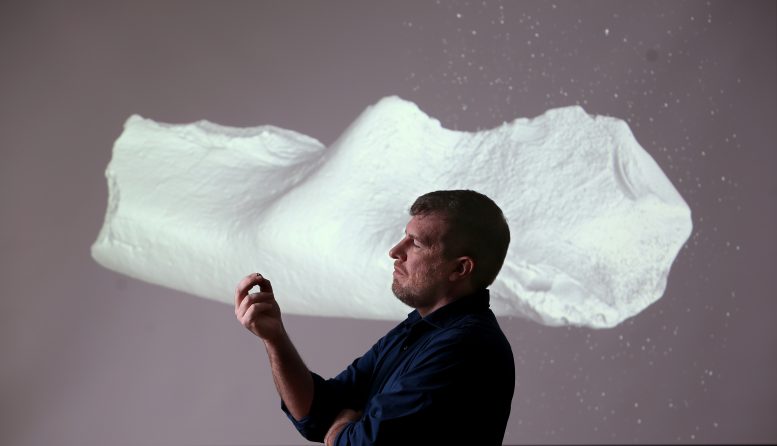Six monotremes living in the same place at the same time, 100 million years ago at Lightning Ridge, NSW. Clockwise from lower left: Opalios splendens, a newly described species dubbed an ‘echidnapus’; Stirtodon elizabethae, the largest monotreme of the time; Kollikodon ritchiei, with hot-cross-bun shaped molars; Steropodon galmani, now known from additional opalised fossils; Parvopalus clytiei, the smallest monotreme of the time; and Dharragarra aurora, the earliest known species of platypus. Credit: Illustration by Peter Shouten
Australian researchers have discovered the oldest confirmed platypus specimen along with a new 
Portrait of Paleontologist Professor Kris Helgen holding a tiny tooth fragment dated at one hundred million years old (and projected at scale in background) on-site at the Australian Museum in Sydney where much of the academic work about the finding was made. Credit: Photograph by James Alcock / Australian Museum
“Opalios splendens sits on a place in the evolutionary tree prior to the evolution of the common ancestor of the monotremes we have today. Its overall anatomy is probably quite like the platypus, but with features of the jaw and snout a bit more like an echidna – you might call it an ‘echidnapus’,” Professor Helgen said.
“The story of how our egg-laying mammals evolved is ‘toothy to toothless’ on the oldest monotreme, Teinolophos trusleri, which dates back to Victoria 130 million years ago. What we see at Lightning Ridge is that by 100 million years ago, some of the monotremes still have five molars but some of them are down to three,” Professor Helgen said.
The Mystery of Monotreme Evolution
Professor Flannery highlighted that today, echidnas have no teeth, and platypuses too are essentially toothless.
“Adult platypus have no teeth, though juveniles have rudimentary molars. Just when and why adult platypuses lost their teeth after nearly 100 million years is a mystery we think we have solved. It may have been competition with the Australian water rat, which arrived in Australia within the last 2 million years, which caused platypus to seek out softer, slipperier food best processed with the leathery pads that adults use today,” Professor Flannery said.
“What is so unusual about this uniquely Australian story is that in one snapshot we see six different egg-laying mammals living together in Lightning Ridge over 100 million years ago. All of them are holding potential evolutionary destinies that can go off in different directions, and all of them are deep distant ancestors and relatives of the current living monotremes.”
Dr Matthew McCurry, Curator of Palaeontology, Australian Museum, said the discovery of three new genera of monotremes helps to piece together their remarkable evolutionary story.
“There are six species of monotremes, including the three newly described here, within the Cenomanian Lightning Ridge fauna of New South Wales making it the most diverse monotreme assemblage on record. Four species are known from a single specimen, suggesting that diversity remains underrepresented. This discovery adds more than 20 percent to the previously known diversity of monotremes,” Dr McCurry said.
“We have very few monotreme fossils, and so finding new fossils can tell us more about where they lived, what they looked like, and how changes in the environment influenced their evolution. Every significant monotreme fossil currently known fits into this evolutionary story, from Teinolophos, the tiny shrew-like creature in Antarctica 130 million years ago to the present day,” Dr McCurry said.
Ongoing Research and Excitement
Co-authors from Museums Victoria Research Institute, Dr Thomas Rich, Senior Curator of Vertebrate Palaeontology, and Honorary Associate Professor Patricia Vickers-Rich AO said these curious, unique, and ancient Australian animals still have the power to interest the scientific world.
“The platypus and echidna are iconic Australian species. The discovery of these several new species in one small area suggests that the family tree of the egg-laying monotremes is far more complicated than the living platypus and echidna alone suggest,” Dr Thomas Rich said.
“As the fieldwork continues in the DOI: 10.1080/03115518.2024.2348753




















Discussion about this post